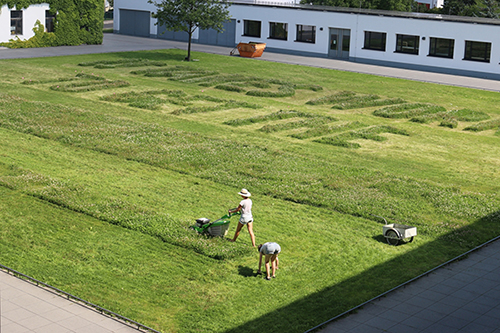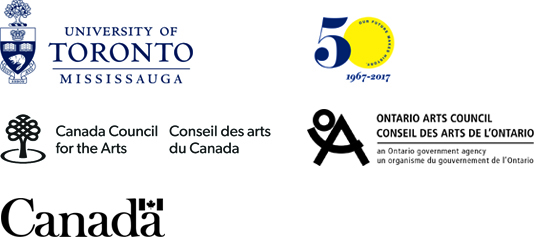
July 20, 2017
University of Toronto Mississauga
Curated by Alison Cooley and
Jayne Wilkinson

Performances and Workshops
Thursday, July 20, 12pm–4pm
12pm
Garden Skool workshop: “Soil On Which We Stand,” with Melisse Watson
e|gallery, CCT building
2pm
It Takes Work to Get the Natural Look public launch with Chloé Roubert
outside Hazel McCallion Academic Learning Centre
2:30pm
Finding words for the feeling performance by Abedar Kamgari
CCT connector
All sites in this project are FREE, open to the public and barrier-free. Some walking is required for performances and workshops.
How far afield? is a series of campus interventions that articulate different forms of care for the landscape by exploring how we come to understand and interact with the living beings—the plants, animals, minerals—that constitute it. On the occasion of the University of Toronto Mississauga’s 50th anniversary, How far afield? addresses the multifaceted histories of the campus ecology, responding to the presence of wild and cultivated spaces, and variegated narratives of land, education, and settlement.
Growth is a familiar and frequently used analogy for education, from Friedrich Fröbel’s invention of Kindergarten (literally “children garden”) to the popular understanding of academic disciplines as “branches.” How can land-based pedagogies and experimental artistic practices complicate the relationships between a park and a school, between exploration and belonging, between proximity and distance? Examining the multiple meanings of “a field”—as a site for the cultivation of plants, as a wild and open space, and as a marker of academic disciplines—this outdoor exhibition brings together artists whose works engage with fields of knowledge and experience in various ways.
In Golboo Amani’s Garden Skool, workshops with local earthworkers operate as sites for community skill-sharing and knowledge exchange, repurposing the University’s landscape as a space rich with pedagogical potential outside the traditional classroom structure. For the first component of Garden Skool, Melisse Watson presents the workshop “Soil On Which We Stand,” identifying soil, plants, trees, and flowers as relatives, and elders, that inform the deepening of our relationships to land. Abedar Kamgari’s site-specific performance, as part of her ongoing project Finding words for the feeling, navigates the unfamiliar spaces of the campus by tracing the intimacies of human presence woven into the University’s public but often inaccessible sites. Chloé Roubert and Gemma Savio’s intervention into the campus lawn, It Takes Work to Get the Natural Look, explores the tensions between modernist architecture and green spaces by foregrounding questions of labour, landscaping, and the constructed definitions of what is natural and what is cultivated.
In works that simultaneously engage with, change, alter, and reconfigure the visible landscapes of the UTM campus, How far afield? reimagines the space of the University by asking artists and viewers to consider the value of natural spaces and the labours of living and working within them.
Melisse Watson (artist name “coyote”) is a poly-racial, Black, Cherokee-identified queer artist who is inspired by stories, choosing the creative mediums that guide their telling. Their practice integrates spoken word, dance, digital media, visual art, and performance and is driven by the capacity for art to provoke and contribute to social justice, community building and healing within systematically oppressed populations.
Abedar Kamgari is an emerging artist, independent curator and arts worker based in Hamilton (ON). Abedar's practice explores the ongoing connections between immigrant experience and locale, language, tradition, belonging, and one's sense of self. Abedar received a BFA from McMaster University in 2016 and was artist-in- residence at the Hamilton Artists Inc. Cotton Factory Residency Program in 2016-2017. Abedar has exhibited at Xpace Cultural Centre, McMaster Museum of Art, Hamilton Artists Inc., Trinity Square Video, The Art Gallery of Ontario and is currently preparing an exhibition for The Art Gallery of Hamilton for Fall 2017.
Chloé Roubert is an artist and anthropologist whose practice is research-driven and blends writing and design. She is interested in human-organic life relations, urban space, and taxonomies. Her work has been shown at the Banff Center for the Arts in Canada, Bétonsalon in Paris and the Bauhaus-Dessau Foundation in Germany.
Gemma Savio is an architect and academic. Her research is focused on the processes of architectural production under the accelerated conditions of political economy across the twentieth century. Savio is a PhD candidate at the University of Newcastle (Australia).
The Blackwood Gallery gratefully acknowledges the support of the University of Toronto Mississauga, the UTM50 Anniversary Fund, the Canada Council for the Arts, and the Ontario Arts Council.
Funding for additional staff support made possible through the Young Canada Works in Heritage Organizations program, Department of Canadian Heritage. The Canadian Museums Association administers the program on behalf of the Department of Canadian Heritage.
